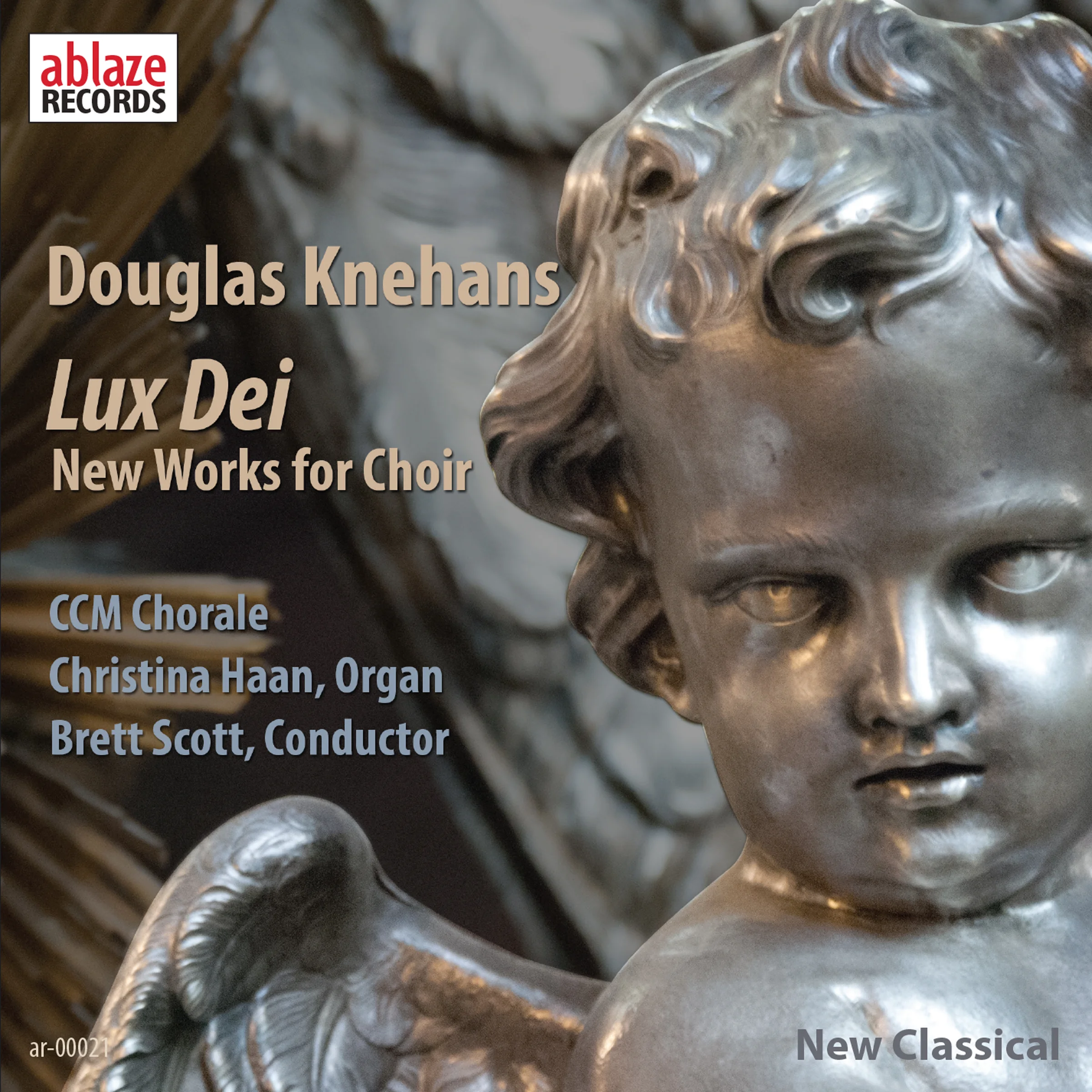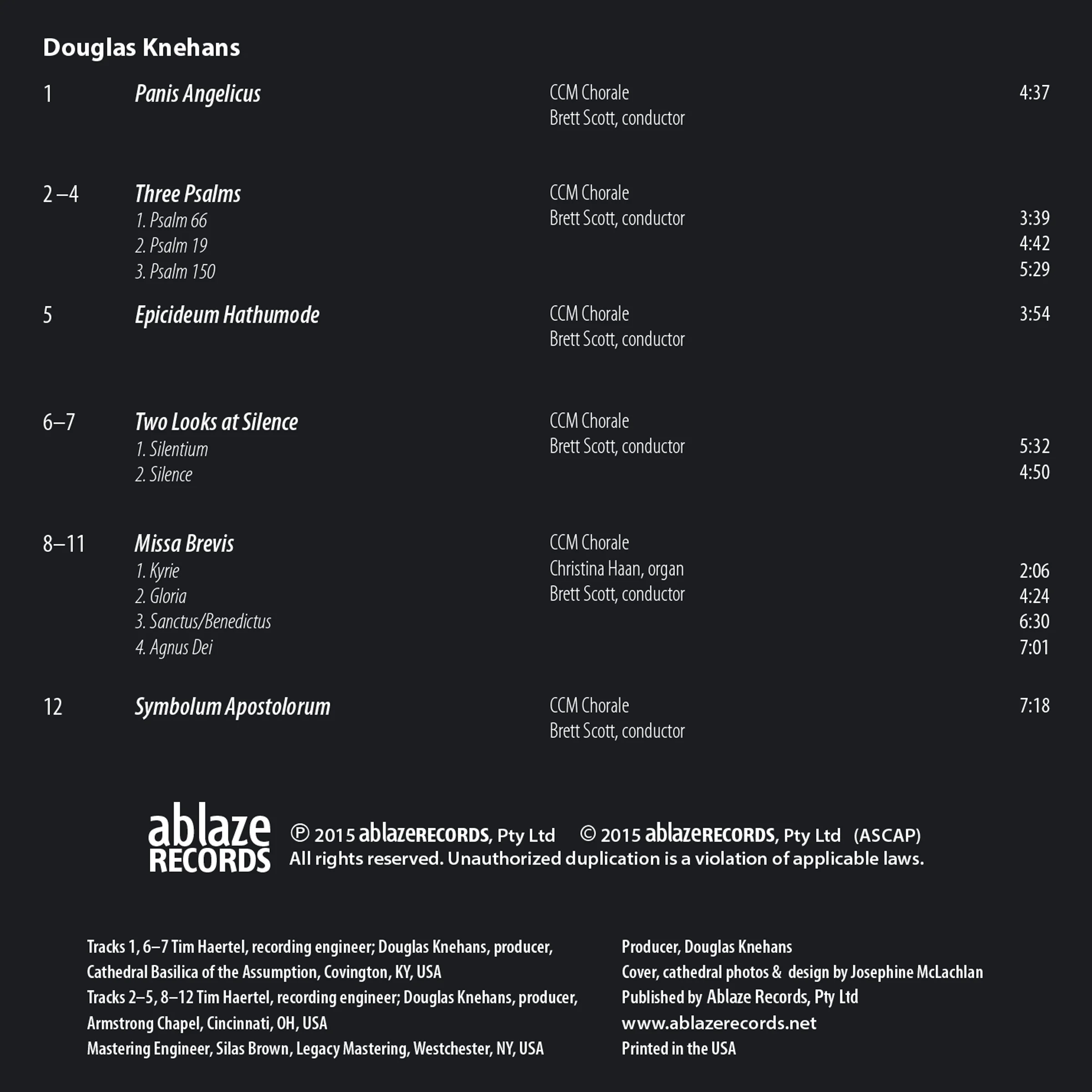ar-00021Douglas KnehansLux Dei


ar-00021Douglas KnehansLux Dei
“…this is a radiant disc of music by a composer who is blessed with a tremendous imagination and who clearly has great affinity with writing for choir. There is a huge amount of beauty to be found here. Put simply, Knehans locates and amplifies the spiritual within the religious.
Colin Clarke—Fanfare Magazine
KNEHANS Panis angelicus. Three Psalms. Epicedeum Hathumode. Two Looks at Silence. Missa brevis Symbolum Apostolorum—Brett Scott, cond; CCM Chorale with 1Christina Haan (org)—ABLAZE 00021 (60:09)
My previous experience of the work of Douglas Knehans was passing but positive: a disc of solo cello music that included Knehans’ piece The Other, again on the Ablaze label (reviewed by myself and several other reviewers in Fanfare 39:2. A full disc of his music gives us the chance to spread out and investigate in more detail, as well as experience another facet of his output, that of choral composition.
The main piece on this disc is the Missa brevis, but it is preceded by a number of other works. Knehans has previously been described as reminiscent of Britten and Stravinsky in his choral writing, and this seems fair, particularly the Britten reference. Born in 1957 in Missouri, he was actually educated at Canberra School of Music (Australia) before gaining his Master Degree at Queen’s College, City University of New York and received the first Luigi Dallapiccola Composition Award (in 1991.) From there he went to Yale for his doctorate, studying with, among others, Jacob Druckman and Lukas Foss. His most relevant academic appointment is Dean of the College-Conservatory of Music (CCM) at the University of Cincinnati, for it is this establishment’s choir that recorded the present disc. The actual recordings are split pretty evenly between two venues, Cathedral Basilica of the Assumption in Covington, Kentucky, and Armstrong Chapel, Cincinnati.
Entitled “Lux Dei,” this disc celebrates Knehans’ work for a cappella choir over almost a quarter of a century. Knehans’ own background in Catholicism informs his writing heavily. The opening Panis angelicus is a slow moving but radiant hymn in which the upper voices are tested somewhat in the work’s more agile section (the CCM Chorale copes well.) But it is the rich, sonorous blend of the CCM Chorale that is most impressive, heard in a beautifully balanced recording. The Three Psalms (66, 19 and 150, in that order and sung in Latin) was a prize winner at the First International Sacred Choral Music Festival in the Czech Republic. The sheer joy of “Jubilate Deo” is palpable here; even more impressive is the superb diction of the choir. The more restrained “Caeli enarrant glorium Dei” finds climactic relief even within the mounds of what is at most a healthy mezzo-forte before the famous Psalm 150 (“Laudate eum in sanctis ejus”) reveals a rhythmic life and delivery that indeed occasionally conjures up Stravinsky.
The brief Epicedeum Hathumode of 1991 is a “Lament for Hathumode, Abbess of Gandesheim,” and is a slow-moving expression of profound grief. The choir’s crescendos are like swells of emotional pain; the Two Looks at Silence take a text by A. S. Kline, setting it first in Latin and then in English. The work is dedicated to the composer’s daughter. The florid writing of the first setting, “Silentium,” leaves one in no doubt as to just how at home Knehans is writing in this medium; the more restrained “Silence” seems to interiorize the text further, perhaps reflecting the closer proximity to the choir’s home language. The two effectively operate as different sides of the same coin.
By far the most extended composition on the disc, the Missa brevis adds organ to the mix, immediately dramatic in the opening “Kyrie eleison” and certainly extending that sense of the dramatic in the ecstatic opening of the ensuing “Gloria.” Solo voices are used effectively at “Et in terra pax”, but the work’s crowning moment exists in the contrast between the shining, exultant close of the “Gloria,” caught simply magnificently in this recording, and the gentle, otherworldly organ opening of the “Sanctus,” the twin gently unfolding lines in the organ heard against quiet statements of the word Sanctus that drip downwards like rain. The darkest terrain is saved for the “Agnus Dei,” where the most advanced harmonies of the work create an atmosphere of what might be described as transcendental desolation that undercuts even the final “dona nobis pacem” (superb control by the upper voices in those final moments.)
The final piece on the disc is Symbolum apostolorum (“Credo in Deum Patrem omnipotentem”), a setting of great contrasts, where fragile solo voice suddenly finds itself set against full-on choral blocks. Dynamics themselves are clearly rehearsed to the last degree, so skillful is the delivery here. Strangely, this is the work that evoked the least emotional response in the present writer; the level of inspiration seems just a touch down on the rest of the disc’s exalted standards.
With loads of space given to artist and composer biographies and full choir listing of personnel, perhaps it would have been nice to have more information about the pieces themselves in the booklet. The date 1991 for the Epicedeum came about because of a publisher’s website, not from material on hand, for example. Small caveats apart, this is a radiant disc of music by a composer who is blessed with a tremendous imagination and who clearly has great affinity with writing for choir. There is a huge amount of beauty to be found here. Put simply, Knehans locates and amplifies the spiritual within the religious.
Colin Clarke—Fanfare Magazine